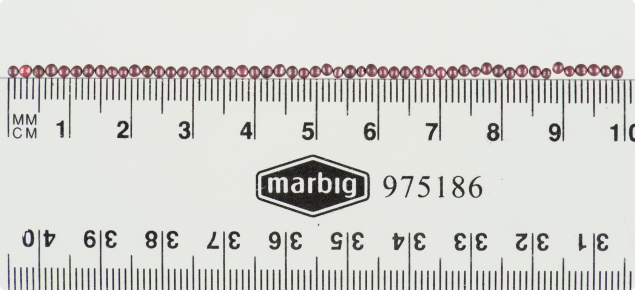There is a close relationship between the number of canola seeds that line up along a 10cm length of ruler and the number of seeds per kg (R2=0.97).
This makes it simple to estimate the seed size of your retained open pollinated seed. Line up the seed as closely as possible along a 10cm portion of your ruler, then count the number of seeds used. Refer to the table below and match the number of seeds per 10cm with the estimate of the number of seeds per kilogram.
| Canola seeds per 10cm line | Canola seeds per kg |
|---|---|
| 45 | 130 000 |
| 46 | 144 000 |
| 47 | 157 000 |
| 48 | 170 000 |
| 49 | 184 000 |
| 50 | 197 000 |
| 51 | 210 000 |
| 52 | 223 000 |
| 53 | 237 000 |
| 54 | 250 000 |
| 55 | 263 000 |
| 56 | 277 000 |
| 57 | 290 000 |
| 58 | 303 000 |
| 59 | 317 000 |
| 60 | 330 000 |
| 61 | 343 000 |
| 62 | 357 000 |
| 63 | 370 000 |
| 64 | 383 000 |
| 65 | 397 000 |
| 66 | 410 000 |
The photo at the top of the page shows 52 ATR Bonito seeds along 10cm of ruler. Use the table to see that this correlates with 223 000 seeds/kg.
Another way to estimate the number of seeds/kg, is to count out 1000 seeds and weigh, on scales that can measure 0.1 of a gram (or count out more seed for less accurate scales).
Seeds per kg = (1000 x 1000) / weight of 1000 seeds (g)
For example, 1000 seeds of retained open pollinated (OP) seed weighed 2.9g.
Therefore seeds per kg = (1000 x 1000) / 2.9 = 344 828 seeds per kg.
Another alternative is to use the seed testing services of AGWEST Plant Laboratories.
Acknowledgments
This work was completed through the Department of Primary Industries and Regional Development's Tactical Break Crop Agronomy project. This project is co-funded by DPIRD and Grains Research and Development Corporation.

